Статьи журнала - International Journal of Intelligent Systems and Applications
Все статьи: 1126
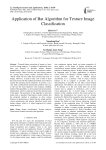
Application of bat algorithm for texture image classification
Статья научная
Textural feature extraction of image is a basic work for image analysis. A number of approaches have been put forward to describe texture features quantitatively, such as gray level co-occurrence matrix, fractal wavelet, Gabor wavelet and local binary pattern etc, among them texture feature extracted based on “tuned” mask will not suffer from rotation and scale of images. However, it needs to take a lot of time to learn the tuned mask with the traditional methods and could not acquire the satisfying mask sometimes. In essence, it is a very hard combinational optimization problem and easy to fall into the local optimum with mountain climbing method. Bat algorithm is a newly proposed meta-heuristic optimization, which is employed to tune the optimal mask in the paper. The procedure of bat algorithm to learn the tuned mask is detailed. Experiments results testifies that the proposed method is propitious to draw texture features, its performance is better than the simple particle swarm optimization and genetic algorithm based mask tuning scheme, which is a robust approach for texture image analysis.
Бесплатно
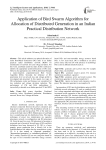
Статья научная
This article addresses an optimal allocation of multi Distributed Generation (DG) units in an Indian practical radial distribution network (RDN) for minimization of network loss and voltage deviation. For this work, combined sensitivity index (CSI) is utilized to identify the appropriate positions/locations of DG units. However, the appropriate size of DG is determined through a nature-inspired; population-based Bird Swarm Algorithm (BSA). Secondly, the influence of DG penetration level on network loss and voltage profile is investigated and presented. In this regard, two types of DG technologies (solar and biomass) are considered for loss reduction and voltage deviation reduction. The performance of CSI and BSA methodology is successfully evaluated on an Indian practical 52-bus RDN.
Бесплатно
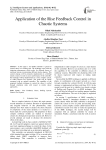
Application of the Rise Feedback Control in Chaotic Systems
Статья научная
In this paper a new RISE controller is gained to control chaos in a tracking task. The technique copes with the chattering phenomenon whilst works for different classes of nonlinear systems incorporating different relative degrees. This control strategy will be primarily implemented on a Duffing chaotic system. In order to assess performance of the controller, the technique will be implemented on a more complex system, so called Genesio-Tesi dynamic. The result will be finally compared with an optimal controller. The capability of the proposed feedback technique to control the chaos is verified through simulation study with respect to similar classic approaches.
Бесплатно
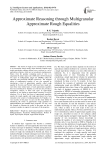
Approximate Reasoning through Multigranular Approximate Rough Equalities
Статья научная
The notion of rough set was introduced by Pawlak as an uncertainty based model, which basically depends upon single equivalence relations defined over a universe or a set of equivalence relations, which are not considered simultaneously. Hence, from the granular computing point of view it is unigranular by nature. Qian et al in 2006 and in 2010 introduced two types of multigranular rough sets (MGRS) called the optimistic and pessimistic MGRS respectively. The stringent notion of mathematical equality of sets was extended by introducing a kind of approximate equality, called rough equality by Novotny and Pawlak, which uses basic rough sets. Later three more related types of such approximate equalities have been introduced by Tripathy et al. He has also provided a comparative analysis of these four types of approximate equalities of sets leading to approximate reasoning in real life situations. Two of these four types of approximate equalities; namely the rough equality and rough equivalence have been extended to the context of multigranulations by Tripathy et al very recently. In this paper we carry out this study further by introducing the notion of approximate rough equalities for multigranulations and establish their properties. We use a real life example to illustrate the results in the paper and also to construct examples in support of some parts of the properties.
Бесплатно
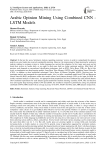
Arabic Opinion Mining Using Combined CNN - LSTM Models
Статья научная
In the last few years, Sentiment Analysis regarding customers' reviews in order to comprehend the opinion polarity on social media has received considerable attention. However, the improvement of deep learning for sentiment analysis relating to customer reviews in Arabic language has received less attention. In fact, many users post and jot down their reviews in Arabic daily, so we ought to shed more light on Arabic sentiment analysis. Most likely all previous work depends on conventional classification techniques, such as KNN, Naïve Bayes (NB), etc. But in this work, we implement two deep learning models: Long Short Term Memory (LSTM) and Convolution Neural Networks (CNN), in addition to three traditional techniques: Naïve Bayes, K-Nearest Neighbor (KNN), Decision trees for sentiment analysis and compared the experimental results. Also, we offer a combined model from CNN and Recurrent Neural Network (RNN) architecture where this model collects local features through CNN as the input for RNN for Arabic sentiment analysis of short texts. An appropriate data preparation has been conducted for each utilized dataset. Our Conducted experiments for each dataset against traditional machine learning classifier; KNN, NB, and decision trees and regular deep learning models; CNN and LSTM, has resulted in impressive performance using our proposed combined (CNN-LSTM) model with an average accuracy of 85,83%, 86,88% for HTL and LABR datasets respectively.
Бесплатно
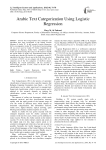
Arabic Text Categorization Using Logistic Regression
Статья научная
Several Text Categorization (TC) techniques and algorithms have been investigated in the limited research literature of Arabic TC. In this research, Logistic Regression (LR) is investigated in Arabic TC. To the best of our knowledge, LR was never used for Arabic TC before. Experiments are conducted on Aljazeera Arabic News (Alj-News) dataset. Arabic text-preprocessing takes place on this dataset to handle the special nature of Arabic text. Experimental results of this research prove that the LR classifier is a competitive Arabic TC algorithm to the state of the art ones in this field; it has recorded a precision of 96.5% on one category and above 90% for 3 categories out of the five categories of Alj-News dataset. Regarding the overall performance, LR has recorded a macroaverage precision of 87%, recall of 86.33% and F-measure of 86.5%.
Бесплатно
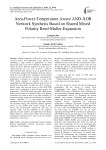
Статья научная
Modern Integrated circuits (ICs) suffer from excessive power and temperature issues because of embedding a large number of applications on small silicon real estate. Low power technique is introduced to reduce the power. With the reduction of power, area of circuit increases and vice versa. It shows a trade-off nature between them. Increase of area is against the trend of technology scaling which demands small area. Due to small area and high power dissipation, power-density increases. As power-density is directly converging into temperature, it emerges as a challenge in front of the VLSI design engineer to minimize the effect of temperature by reducing power-density. In this work, an attempt has been made to reduce the effect of power-density along with area and power so that AND-XOR based circuit is balanced in terms of area, power, and temperature. AND-XOR based reed-muller (RM) mixed polarity circuit forms are considered in this work. Polarity conversions are made in such a way that possibility of maximum sharing among the sub-function is increased. Genetic algorithm is (a non-exhaustive heuristic algorithm) used to select the polarity of the input variable for maximum sharing. The proposed synthesis approach shows 27.11%, 20.69%, and 32.30% savings in area, power, and power-density respectively than that of reported results. For the validation of the proposed approach, the best solutions are implemented in Cadence digital domain to obtain actual silicon area and power consumption. HotSpot tool is used to get the absolute temperature of the circuit.
Бесплатно
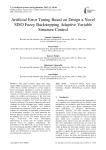
Статья научная
This paper examines single input single output (SISO) chattering free variable structure control (VSC) which controller coefficient is on-line tuned by fuzzy backstepping algorithm to control of continuum robot manipulator. Variable structure methodology is selected as a framework to construct the control law and address the stability and robustness of the close loop system based on Lyapunove formulation. The main goal is to guarantee acceptable error result and adjust the trajectory following. The proposed approach effectively combines the design technique from variable structure controller is based on Lyapunov and modified Proportional plus Derivative (P+D) fuzzy estimator to estimate the nonlinearity of undefined system dynamic in backstepping controller. The input represents the function between variable structure function, error and the modified rate of error. The outputs represent joint torque, respectively. The fuzzy backstepping methodology is on-line tune the variable structure function based on adaptive methodology. The performance of the SISO VSC based on-line tuned by fuzzy backstepping algorithm (FBSAVSC) is validated through comparison with VSC. Simulation results signify good performance of trajectory in presence of uncertainty joint torque load.
Бесплатно
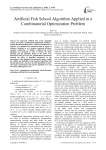
Artificial Fish School Algorithm Applied in a Combinatorial Optimization Problem
Статья научная
An improved artificial fish swarm algorithm (AFSA) for solving a combinatorial optimization problem—a berth allocation problem (BAP), which was formulated. Its objective is to minimize the turnaround time of vessels at container terminals so as to improve operation efficiency customer satisfaction. An adaptive artificial fish swarm algorithm was proposed to solve it. Firstly, the basic principle and the algorithm design of the AFSA were introduced. Then, for a test case, computational experiments explored the effect of algorithm parameters on the convergence of the algorithm. Experimental results verified the validity and feasibility of the proposed algorithm with rational parameters, and show that the algorithm has better convergence performance than genetic algorithm (GA) and ant colony optimization (ACO).
Бесплатно
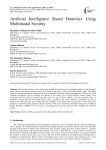
Artificial Intelligence Based Domotics Using Multimodal Security
Статья научная
All electronic devices in our cutting-edge technology world must be networked together via the Internet if users want to have remote access to them. As a result, it may raise a variety of serious security issues. This study suggests a remote access home automation security system that incorporates utilizing the Internet of Things (IoT), and Artificial Intelligence (AI) for ensuring the security of the house. For a highly efficient security system, Face recognition has been used to maneuver the door access. In case of power outage or for any technical issues, an alternative security PIN has been added which is only accessible by the owner. Moreover, individuals are able to monitor and control the door access along with other attributes of the house using an application. In this work, Face detection is performed using the Haar Cascade classifier, while face recognition is performed using the Local Binary Pattern Histogram (LBPH). 95.7% accuracy in recognizing faces has been achieved after evaluating the proposed system.
Бесплатно
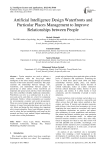
Статья научная
Tourist attraction was used to achieve a stable waterfront, while the fuzzy-logic added intelligence to the select strategy through an automatic selection of the tourist attraction coefficient. This paper examines the relationship between heritage sites, waterfronts, and relationships between people in present-day in urban culture. Urban waterfronts are important and special assets and that, when redeveloped, they often contribute to healthy traditional communities. Waterfronts can serve as a unifying force in a city or town and can be, and often are, a force for community enrichment. Further, vibrant communities are essential for environmental, economic and social advancement. There are several strategy specific principles as a way to improve of usage from particular places and waterfront city. Select and design the best strategy play important role to tourist attraction. Fuzzy logic inference system is used to select the best methodology and based on this research and fuzzy logic method, striped methodology is used to have a best performance.
Бесплатно
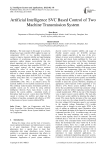
Artificial Intelligence SVC Based Control of Two Machine Transmission System
Статья научная
The main target in this paper is to present, design fuzzy logic controller (FLC) applied to static var compensator (SVC) on two machine transmission system to improve transient stability and rapid damping oscillations of synchronous generators, when power generators sudden changes occur.stability that also played important role in power systems. static var compensator with fuzzy logic controller (SVCFLC) is a new control strategy can help improve transient stability.The effect of three phase fault causes instability on power system. By and large, it is very difficult to control machine speeds ,rotor angle and voltage during three-phase fault.SVCFLC is a voltage stablizer using three static var compensator which are controlled by SVC with fuzzy logic controller(FLC).The FLC is an effective device for transient stability of two-mashine transmission system. The nonlinear model dynamic formulation problem in unstable system can be solved by using artificial intelligence theorem. Fuzzy logic theory is used to improve the system stability . simulation results of three-phase fault in power system show that SVCFLC caused to increase the stability and damp out the oscillation of machine, compared with effective of SVC in the presence of power system stabilizer(PSS).
Бесплатно
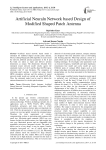
Artificial Neural Network based Design of Modified Shaped Patch Antenna
Статья научная
Artificial neural network based model is estimated for modified shaped circular patch antenna. The Levenberg Marquardt (LM) algorithm is used to train the network, different antenna parameters in the X and Ku band are taken as input and delivers antenna dimensions as output. The dimensions obtained from estimated neural network model closely agrees the simulated results over the X and Ku band for FR4 epoxy substrate with 1.5 mm thickness. The simulation of microstrip patch antenna is carried out using Ansoft HFSS simulation software and the analysis of neural network model results are carried out using MATLAB. Thus, the estimated model can be used to obtain the antenna dimensions for circular patch antenna.
Бесплатно
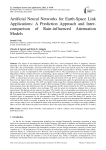
Статья научная
The impact of rain-influenced attenuation (RIA) has a more pronounced effect as frequency increases, especially in the tropical zones with heavier rainfall than the temperate zones. The International Telecommunication Union (ITU) has recommended a universal model which may not fit well in this tropical region due to the temperate data used to develop the model. It is therefore necessary to adopt locally measured data to develop a suitable model for each region, as also recommended by ITU recommendation 618-13. The experimental site for this study is at the Department of Physics, Federal University of Technology, Akure, Nigeria (7.299° N, 5.147° E) in the tropical rainforest region of Nigeria. In the present work, the backpropagation neural network (BPNN) of the artificial neural network (ANN) is trained based on time-series rain rates data collected between 2015 and 2019 to predict time-series RIA. Based on four inputs (rain rate, rain heights, elevation angle, and polarization angle), the generated data was subjected to training, validation, and testing. The ANN was further trained using the Levenberg-Marquardt algorithm to fit the inputs and the targets to create a dynamic model for RIA forecasting. Further validation was tested using actual data of rain attenuation from a Ku-band beacon at the site. Subsequently, the RIA model created by the ANN was compared to those generated using the synthetic storm technique, ITU, and the actual rain attenuation obtained from a beacon measurement. The highest rain rate observed was about 225.8 mm/hr with a corresponding rain attenuation of about 61 dB as estimated by the SST model and about 68 dB by the ITU model, while the predicted attenuation by the ANN is 55 dB. This implies that an extra power of 6 dB and 13 dB is added by the SST model and ITU model, respectively, for the downlink signal, to compensate for the rain attenuation link. The results also reveal that during 0.01 percent of an average year that signal may be attenuated, a relatively tiny margin of error between anticipated rain attenuation using ANN and the SST model is exceeded. In general, the new ANN-generated RIA model had the lowest root mean square error, average relative error, and standard deviation at the selected time percentages, according to the model validation. Hence, the new ANN model can predict more effective RIA in the region when compared with the global ITU-R model.
Бесплатно
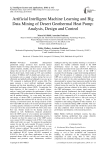
Статья научная
Nowadays sustainable underground geothermal energy resources have received special attention thanks for being characterized as clean, zero-carbon footprint, reliable, and free source of renewable energy that can run all year long and around the clock. Barren desert lands, which make up 33% and contribute to almost 30 Million km² of global land surface area, is increasingly seen as supply of green energy but not yet efficiently and globally utilized although it can save up to 70% compared to traditional HVAC systems bills. This paper presents a novel artificial intelligent machine learning and big data algorithm to analyze and control geothermal heat pump system (GHP). In particular, the main objective of this research is to model, design, analyze, control and optimize the performance of desert underground GTH system based on thermodynamics laws and AI machine learning. As a case study, the analysis and design of desert GHP is performed based on the annual weather data collected for Al Ain city in UAE. By selecting a horizontal layout, the design analysis results show that GHP unit needs a 66 m total trench length with a cooling capacity estimated of 12.4 kW, heat pump COP of 2.8 and 1.6 for the system COP with 30.3 L/min water flow rate. Similar results for the heating system are obtained as well. Furthermore, financial calculations show the GHP system is very economic and competitive comparing with the traditional cooling/heating systems. It is figured out that the annual cost of the GHP system costs around $1676 compared with $7992 if air-cooled chiller and boiler are used. To maintain the geothermal system for one life cycle (usually 20 years) it needs to spend only $14,659 compared with $109,944 in case HVAC system is utilized. The overall life cycle cost in case of the desert GHP system does not exceed (45%) of the traditional HVAC system ($81,881 compared to $181,974). One of the direct applications is use this proposed desert GHP to cool the roof water tank for domestic and personal usage. Furthermore, artificial intelligent and big data machine learning is executed to analyze the weather conditions related to the GHP performance based on huge number of thermal observations recorded for the years 2015-2018. Moreover, the mean switch-off control hours of the GHP is examined by developing a supervised learning predictive model. For the purpose of validation a four ton Bosch GHP unit is selected as a benchmark. Switch-off control hours per month for the entire geothermal data set are demonstrated by using a linear regression model that help to guide the controller to switch-on/switch-off the system without having the need for the real data measurement. One primary outcome obtained is the ability to optimize the GHP performance, save primary input energy and operation periods. Furthermore, the results interprets that almost one third of the year is in a switched-off saving mode (33%), compared to 67% in switch-on mode. This smart big data control will lead to a life-cycle saving of $27,020. This AI saving strategy is found to be competitive and leading compared to other schemes. It is worthy to recommend linking GHP controller with real-time radar or weather station that will fed the system with real data conditions which would lead to improving its performance and dispense costly measuring sensors.
Бесплатно
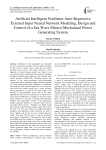
Статья научная
Utilization of the sustainable and renewable sea wave energy has recently received special attention by the virtue of being a free, clean and zero-carbon footprint power source. This paper presents a novel approach to model, design, analyze and control a sea wave electric power generating system using an artificial intelligent nonlinear auto regressive with external input neural networks (NARX-NN). Modeling design, and analysis of an electro-mechanical power-generating system using linear permanent magnet generator attached to a dual spring-mass-damper platforms is introduced. The purpose of this proposed generator is to convert sea and ocean wave kinetic energy into a useful electrical power generated as a result of the linear motion core through an electromagnetic stator. One of the direct applications of the sea wave generator is to install one or more units on shipboard to contribute to its power utility needs whether it is moving or floating. The dynamical stability and compensator control of the spring-mass damper generator platform is analyzed along with its associated electric power. Faraday’s law based results show that the output induced voltage ranges from -60 to 60 volts (120 volts p-p). Moreover, artificial intelligent nonlinear auto-regressive neural networks are used to train, validate, and test the sea wave electric generator output. Two-layer NN are used to train the dynamical input-output relationship of the proposed system using one hidden layer that contains of 10 neurons. Two delays are used, one for motion input and one for voltage output. The NARX-NN training demonstrates that the network is being trained efficiently and tracks the actual sea wave electric generator output with a very low mean-square-error performance response without the need to measure the variables.
Бесплатно
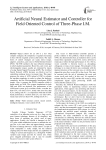
Artificial neural estimator and controller for Field Oriented Control of three-phase I.M.
Статья научная
Speed control for an I.M is a few what complex strategies; the complexity is regularly increasing in line with the required system achievement. The main forms of control strategies are scalar, direct torque, adaptive, sensorless, and vector or Field Oriented Control (FOC). The FOC method is the most efficient technique in which machine parameters: Rotor flux, unit vector, and electromagnetic torque, usually are estimated by means of using Digital Signal Processing (DSP). The Artificial Neural Network (ANN) becomes an effective tool for controlling nonlinear device in present time. This paper proposes the using of ANN instead of DSP to estimate the machine parameters in order to reduce the hardware complexity and the Electromagnetic Interference (EMI) impact. Also, it presents the PI-NN controller which is based totally on ANN. The systems simulations for both DSP and ANN are depicted. The performance of the ANN-based system gives excellent results: overshot less than 0.5%, rise time 0.514 s, steady state error less than 0.2%, settling time 0.7 s. in conjunction with that of DSP-based performance: overshot about 2%, rise time 0.64 s, steady state error less than 0.4%, settling time 0.75 s.
Бесплатно
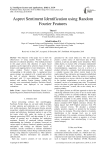
Aspect sentiment identification using random Fourier features
Статья научная
The objective of the paper was to show the effectiveness of using random Fourier features in detection of sentiment polarities. The method presented in this paper proves that detection of aspect based polarities can be improved by selective choice of relevant features and mapping them to lower dimensions. In this study, random Fourier features were prepared corresponding to the polarity data. A regularized least square strategy was adopted to fit a model and perform the task of polarity detection Experiments were performed with 10 cross-validations. The proposed method with random Fourier features yielded 90% accuracy over conventional classifiers. Precision, Recall, and F-measure were deployed in our empirical evaluations.
Бесплатно
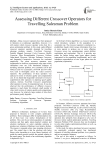
Assessing Different Crossover Operators for Travelling Salesman Problem
Статья научная
Many crossover operators have been proposed in literature on evolutionary algorithms, however, it is still unclear which crossover operator works best for a given optimization problem. In this study, eight different crossover operators specially designed for travelling salesman problem, namely, Two-Point Crossover, Partially Mapped Crossover, Cycle Crossover, Shuffle Crossover, Edge Recombination Crossover, Uniform Order-based Crossover, Sub-tour Exchange Crossover, and Sequential Constructive Crossover are evaluated empirically. The select crossover operators were implemented to build an experimental setup upon which simulations were run. Four benchmark instances of travelling salesman problem, two symmetric (ST70 and TSP225) and two asymmetric (FTV100 and FTV170), were used to thoroughly assess the select crossover operators. The performance of these operators was analyzed in terms of solution quality and computational cost. It was found that Sequential Constructive Crossover outperformed other operators in attaining 'good' quality solution, whereas Two-Point Crossover outperformed other operators in terms of computational cost. It was also observed that the performance of different crossover operators is much better for relatively small number of cities, both in terms of solution quality and computational cost, however, for relatively large number of cities their performance greatly degrades.
Бесплатно
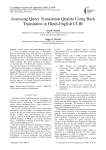
Assessing Query Translation Quality Using Back Translation in Hindi-English CLIR
Статья научная
Cross-Language Information Retrieval (CLIR) is a most demanding research area of Information Retrieval (IR) which deals with retrieval of documents different from query language. In CLIR, translation is an important activity for retrieving relevant results. Its goal is to translate query or document from one language into another language. The correct translation of the query is an essential task of CLIR because incorrect translation may affect the relevancy of retrieved results. The purpose of this paper is to compute the accuracy of query translation using the back translation for a Hindi-English CLIR system. For experimental analysis, we used FIRE- 2011 dataset to select Hindi queries. Our analysis shows that back translation can be effective in improving the accuracy of query translation of the three translators used for analysis (i.e. Google, Microsoft and Babylon). Google is found best for the purpose.
Бесплатно

